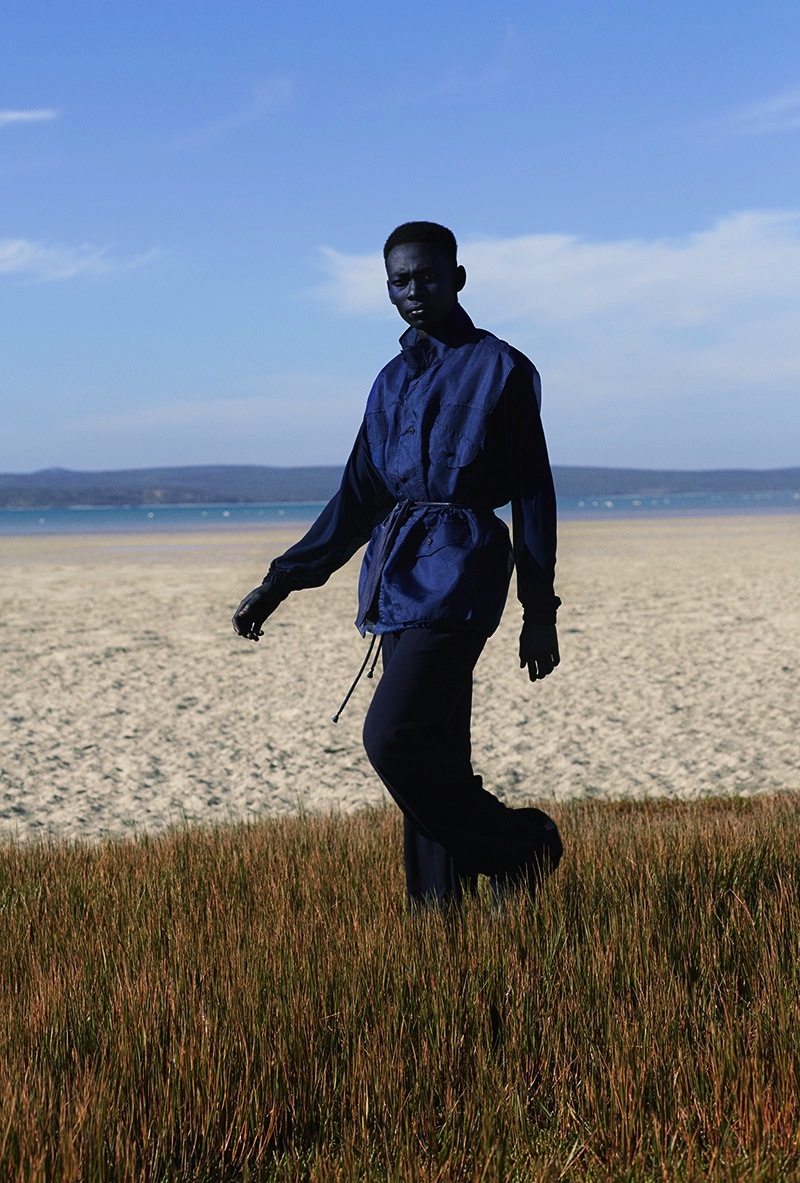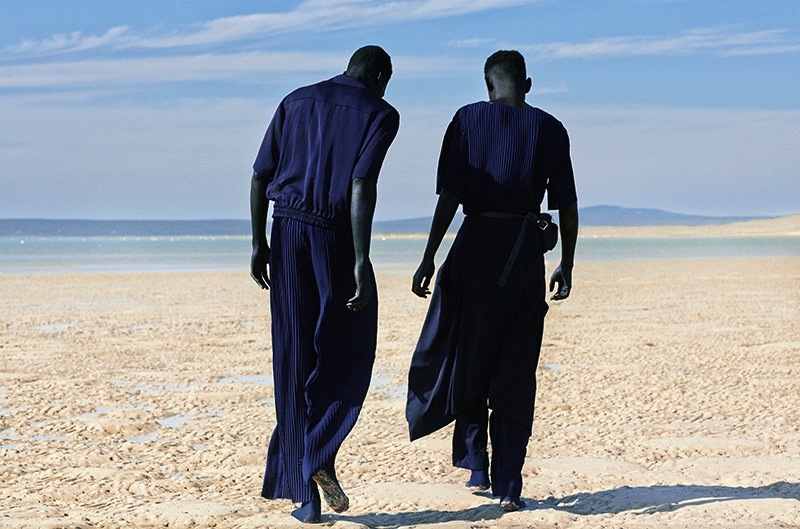Lukhanyo Mdingi is a waiter at an American diner in Cape Town. While the 23-year-old says that the job has encouraged him to be more outgoing and share stories with his customers, we’re willing to wager many of them aren’t aware that their cheerful server is one of South Africa’s most promising design talents when they sit down for a burger.
In 2013 — his final year in Cape Peninsula University of Technology’s fashion design program — Lukhanyo was a finalist in an Elle Magazine design competition. With two formative womenswear collections under his belt, he made the switch to menswear and launched his eponymous brand earlier this year. His fall/winter 15 collection — an offering of heavy knits and macrame backpacks inspired by ancient Arabic knotting — debuted at South African Menswear Week, Africa’s first ever men’s fashion week.
Lukhanyo’s most recent collection, spring/summer 16’s Taintless, might be a genderfluid take on Japanese design techniques, but its accompanying lookbook vibrantly showcases the Rainbow Nation’s collaborative creative scene. We caught up with Lukhanyo to learn more.
Tell us about yourself.
I’m from a small town on the East Coast of South Africa called East London. As small as it is, it’s a remarkable little town. Children are constantly outdoors, swimming and playing on the shores of Nahoon Beach and Bonza Bay. But fashion wasn’t a hugely celebrated culture or career in my tiny town. While others aspired to be school teachers or sportsmen, there wasn’t a single soul that I looked up to. At 16, I realized I’d find my feet by surrounding myself with young creatives in an enriching environment, and spent a lot of my happier times in Belgravia Art School. Although I struggled and faced a lot of hurt in my teenage years, I didn’t allow myself to become a victim and instead sought out those that would make a positive contribution to my life. As I slowly learned from others, it allowed me to better myself not only as a creative, but as a human being.
How did you first become interested in fashion?
Honestly, it started with trials and tribulations of the Forrester family from the daytime soap The Bold and The Beautiful. This was probably every little gay boy’s dream show, especially if they were into 80s fashion, Versace knock-offs and Sally Spectra’s sass. The show entailed risqué storylines that weren’t appropriate for kids, but for me, it was beautiful tale of a family house that celebrated fashion — my connection was instant.
What’s exciting about South Africa’s creative scene?
The extraordinary individuals that I have had the opportunity to work with and observe have enriched me. There is a true beauty about the stories behind their processes, their thoughts and their talents. What I love most about South African creatives is the perseverance and hustle that drives them to create and overcome obstacles. It has been, and still is, a struggle to produce my work, but it’s made me realize that a majority of South Africa isn’t ready for a lot of the young designers here. Though there is much change that we want to contribute to here, we don’t want to contain ourselves. I look at my peers and use them as a source of inspiration.

I believe that South Africa is a country that recognizes sports and politics beyond anything else. Arts and culture are not celebrated nearly as much, but that’s ok. Because I have positioned myself in a city where there is creative freedom, it’s such an experience for me to be a witness to others: to see their progression, to hear their stories, to feel their music, to appreciate their crafts and to watch their visions come to life.
Tell us about your most recent lookbook, it’s incredible.
Gabrielle Kannemeyer was behind the artistic direction and styling of the campaign. In March, I gave her a brief description of the collection and she created a story based on its look and feel. It was important for her to use the visual aspects as a way to narrate a story that went far beyond the clothes. Travys Owen, who shot the campaign, shared these sentiments. One of the most beautiful coincidences was that he and Gabbi envisioned the exact same setting. Both chose to take the campaign out into an environment that had a sense of surrealism. He wanted to capture both Toyin and Gandhi as wandering boys in a lost land.
The models’ skin appears to also be navy — how?
The immensely talented Amori Birch painted the boys blue, incorporating different shades of navy and cerulean to add contrast and highlights. It was so beautiful to see how she adapted to both model’s skin colors and blended the makeup to make it seem like their natural pigment. We were all blown away by how she created the visions that were only in our minds.
Recently, models of color —particularly models of African descent like Nykhor Paul — have spoken out about inequality in the industry. As a designer, what’s your take?
I had the greatest pleasure of assisting as an intern on one of Nykhor’s most recent beauty shoots. Listening to her feelings about the lack of diversity and celebration of darker skinned girls made me more conscious of the realities of discrimination that so many seem to face in the industry. But I haven’t felt any lack of diversity in regards to South African designers. The best part about being an African designer is the fact that we’re a Rainbow Nation. My peers and mentors are of different races, different cultures and different aesthetics.
What are your hopes for the future?
I only hope that the fashion industry in South Africa gets empowered and celebrated. Even though there are moments when I want to lash out my frustrations, it’s important that I use this time to transform my country into a place that I envision it to be: a country that has access to textiles, support structures from the government, realistic procedures to access funding, and much more. I am not oblivious to those that are already supportive, but the movement must continue to progress in order for creatives to have viable careers in a country that possesses so much passion, talent and love.


Credits
Text Emily Manning
Lookbook photography Travys Owen, courtesy Lukhanyo Mdingi